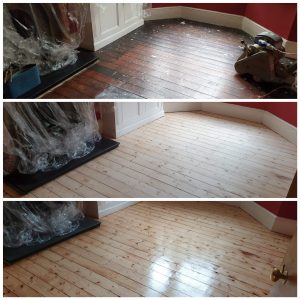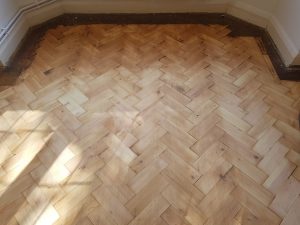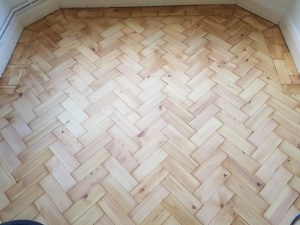Floor sanding is a process of taking off the top layer of a wooden floor with abrasive materials. All solid wood floors including parquet, original floorboards, artistic floors, cork or engineering floors can be sanded as long as they have at least 2mm top layer.
Every floor is sanded differently depending on:
- The type of the floor.
- The thickness of the floor.
- Condition of the wood.
- The type of old finish that needs to sand.
- Deepness of the scratches or dents made previously.
Floor Sanding always involves 3 phases and at least three stages of sanding :

1st phase – Removing the old finish (lacquer, varnish, oil, wax, etc.) and flattening the level differences between the boards, tiles, blocks. Usually, this is made with aggressive sandpaper P36, P24 or even P16, P12 if the situation requires it. It can be done following the grain of the wood in a straight line or diagonally. This phase also includes first stage sanding with the edger machine (sandpaper for the edger needs to be the same grid as the sandpaper that was used on the Belt sander)

2nd phase – Removing the scratches from the 1st phase sanding process by using less aggressive floor sanding paper, and it needs to be done only with the grain of the wood. It can involve a few stages of sanding depending on the finishing grit of the first phase sanding process. If the floor is finished with P24 grit sandpaper, for example, the following sanding needs to be done with P36 or P40 grit sandpaper and as follows up to P60 grit sandpaper. This phase also includes second stage sanding with the edger machine (sandpaper for the edger needs to be the same grit as the sandpaper that was used on the belt sander)

3rd phase – Removing the scratches from the 2nd stage sanding process and preparing for buffing. When this phase is finished, the floor needs to be nice and smooth without any scratches on it. The final grit sandpaper for this Phase is P100 or P120 grit for the belt sander. This phase also includes first stage sanding with the dual-action sander (sandpaper for the dual-action sander needs to be done in 2 stages:
first- the same grit as the sandpaper that was used on the belt sander in phase 2 and second with at least P100 grit sandpaper).

FLOOR SANDING PRICES
| FLOOR SANDING | – from £12 per m2 |
| FLOOR SANDING AND 3 COATS OF LAQUER | – from £15 per m2 |
| FLOOR SANDING AND 2 COATS OF OIL | – from £16 per m2 |
- Condition of the floor
- Type of the floor
- Shape of the room/s
- Size of the room/s
- Wood floor pattern
- Time needed to prepare and finish the floor
TAKE A LOOK AT WHAT OUR CLIENTS ARE SAYING ABOUT US
Sanding with the Belt sander
– Sanding with the grain of the wood
This method of sanding is chosen, preferably when it is possible.
The wood grain needs to be pointing in one direction, and the floor needs to be very flat. Sanding with the grain is not aggressive, and if you want to remove a certain amount of material, it will be difficult this way.
– Diagonal sanding
This method of sanding is a lot more aggressive and effective, the downside of it is removing a lot more material from the floor which reduces the number of times the floor can be sanded in the future.
This method of sanding is preferred when the floor is not even and needs an aggressive sanding, or the grain of the wood is pointing in different directions.
– Sanding across the grain of the wood
This method of sanding is fast, aggressive and wrong and is used if there is no other way because it will require a lot more skills and efforts to remove the scratches from it into the next phases of sanding. Belt or drum machines easily cut thru the grain of the wood, and basically, the sandpaper is taking the grain apart. We are using this method only when there is no other way because of the shape of the floor or when we have to sand very hard or sticky old sealant/ finish.
Machines
We are using the most modern equipment to keep our schedules and your home clean.
We do not use the traditional dust bags which some of our competitors are attaching to their sanding equipment. All of our machines are connected to industrial 3000W dust collectors equipped with HEPA filters. That improves the suction of the integrated fans of our tools and keeps even the smallest dust particles where they belong- into the container of the dust collector.
The machines that we need to do the professional job you deserve.
1. Floor sanding belts or belt sander– is used to do 90% of the floor area, our belt sanders are very powerful and heavy-duty.
2. Edger – is used to for the hard-reach areas where belt sander can not be used. For example, around the walls, under furniture or radiators, small rooms less than 3 square meters, etc. )
3. Orbital sander or dual action sanders – are used to smooth the scratches made from the edger.
4. Delta sander – is used to do the corners of the room and the tiniest bits of the floor area (around radiator pipes, furniture legs, kitchen units, etc.)
5. Buffing or trio machines – are used to smooth the whole floor area, because of the nature of its design, the lower speed and fine sanding abrasives they remove even the smallest scratches and prepare the floor for varnishing, oiling, staining or waxing.
Areas we cover for Floor Sanding London
Our teams cover the entire city of London, including Mitcham and Hersham.
REACH US NOW VIA CONTACT FORM OR PHONE
CALL US: 07824994777
MAIL: info@alphafloorsanding.co.uk








